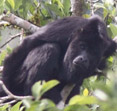Get
To Know
|

The Howler Monkey
The Howler Monkey is among the largest of the New World monkeys. They
range in size from 56 to 92 cm, and like many New World monkeys, they
have prehensile tails. They have a short snout, and wide-set, round nostrils.
Howlers eat mainly top canopy leaves, together with fruit, buds, flowers,
and nuts and have a lifespan of 15 to 20 years. They move quadrapedally
and do not brachiate, usually holding on to a branch with at least two
hands or one hand and the tail at all times. They very seldom leave the
trees, rest about 80 percent of the time and are considered the least
active of all monkeys.
|
|
|
|
My parents, God love 'em, never throw anything away. Usually this is
a source of concern and physical inconvenience--as when you try to maneuver
around the tottering towers of decades-old newspapers that litter their
home--but occasionally it can be a source of revelation, a recovery
from a buried personal archaeology. That's what happened recently.
I was searching for their old copy of The Night before Christmas,
the book my dad used to read to us every Christmas Eve. I figured the
original, if it were there at all, would be too shabby to risk salvaging,
but I thought I might find the same edition on Amazon to read to my
own children. Keeping alive our almost eleven-year-old daughter's flickering
faith in Santa Claus has been something of a crusade with me and my
wife lately, though I'm not sure why.
I didn't find the book I was looking for. What I did find, among the
moldering, masking-taped series of Hardy Boys and Nancy Drew
mysteries that crowd their attic shelves, was a book from 1974,
when I was nine, a book titled Dar Tellum: Stranger from a Distant
Planet. It's the kind of book my daughter still likes to read between
hefty chunks of her favorite fantasies, Harry Potter and Percy
Jackson: a chapter book, yes, but with large print, pictures on
every third or fourth page, and only sixty-four pages in all. So I snatched
it--one less piece of junk for my parents to deal with, one less for
me to deal with when they're gone--and took it home.
That's when I discovered a certain eerie appropriateness in my choice.
I'd remembered the book's basics as soon as I beheld it: the narrator,
a lonely boy whose father works in a top-secret government think tank,
begins to receive telepathic communications from an intergalactic sentience,
Dar Tellum, with whom he forms a friendship. What I hadn't remembered
was the plot's principal conflict. Here's how the narrator tells it:
"It seems that the planet Earth was right in the middle of a big crisis.
Dozens of cities were in danger of becoming flooded. . . . And the reason
for this flooding was that the oceans were getting higher.
"From what I understood, and I'm sure there are gaps here and there,
the smoke from cars and factories goes into the air. A part of this
smoke called carbon dioxide gets into the atmosphere of Earth. It lets
the sun's heat in, but it won't let much heat out. This carbon dioxide
makes a kind of one-way lid on Earth. Heat in, but not much out.
"And this extra heat was warming up the north and south poles. So the
ice was melting and the oceans were getting higher."
How could I have forgotten my introduction (in 1974, mind you) to global
warming? Was the idea so scary I wanted to forget? Or--and this is another
way of asking the same thing--did the concept seem so preposterous,
even more far-fetched than telepathic communication with interstellar
strangers, that I'd dismissed it? To put this succinctly: was I, at
age nine, a climate skeptic?
I suppose I was. And I suppose, at age nine, I was entitled. But now
here we are, a third of a century behind us, an earthling eternity filled
with warnings from senators and scientists alike, and collectively we
are still nine years old. Still wishing the problem gone, stashing it
in our parents' bookshelf, treating it as fantasy rather than fact.
Still, to cite the final words of a grown-up book, Elizabeth Kolbert's
Field Notes from a Catastrophe, waiting for someone else (Dar
Tellum?) to magically make it go away:
"All of the studies and news stories were there for
everyone to read. But the storm of the future lay in the future, while
the costs of preparing for it would have had to be borne in the present.
It was easier, both psychically and economically, to turn away from
the facts. And so life went on as before, and everyone hoped for the
best."
Kolbert is referring to the destruction of New Orleans by Hurricane
Katrina; she finds in our non-response to the warnings that loomed over
that doomed city an apt analogy to our refusal to accept the reality
of global warming. Had she read Dar Tellum, she might have found
an analogy there too: smoke from factories and cars, warming poles,
rising oceans, drowned cities. The stories have always been there for
us to read.
But we've preferred to tell ourselves a different story. A story that
preserves us blameless, childlike, without sin. A story that justifies
our continued denial. A story that erases the one book in our parents'
attic that, years ago, might have told us the truth.
J. David Bell is a recovering academic whose fiction and creative nonfiction
have appeared in such journals as Third Reader, Gander Press
Review, SNReview, The Battered Suitcase, and Queen
City Review. You can follow his exploits and read his stuff at http://bellsyells.blogspot.com/
|
 The
Howler
- Issue Six
The
Howler
- Issue Six